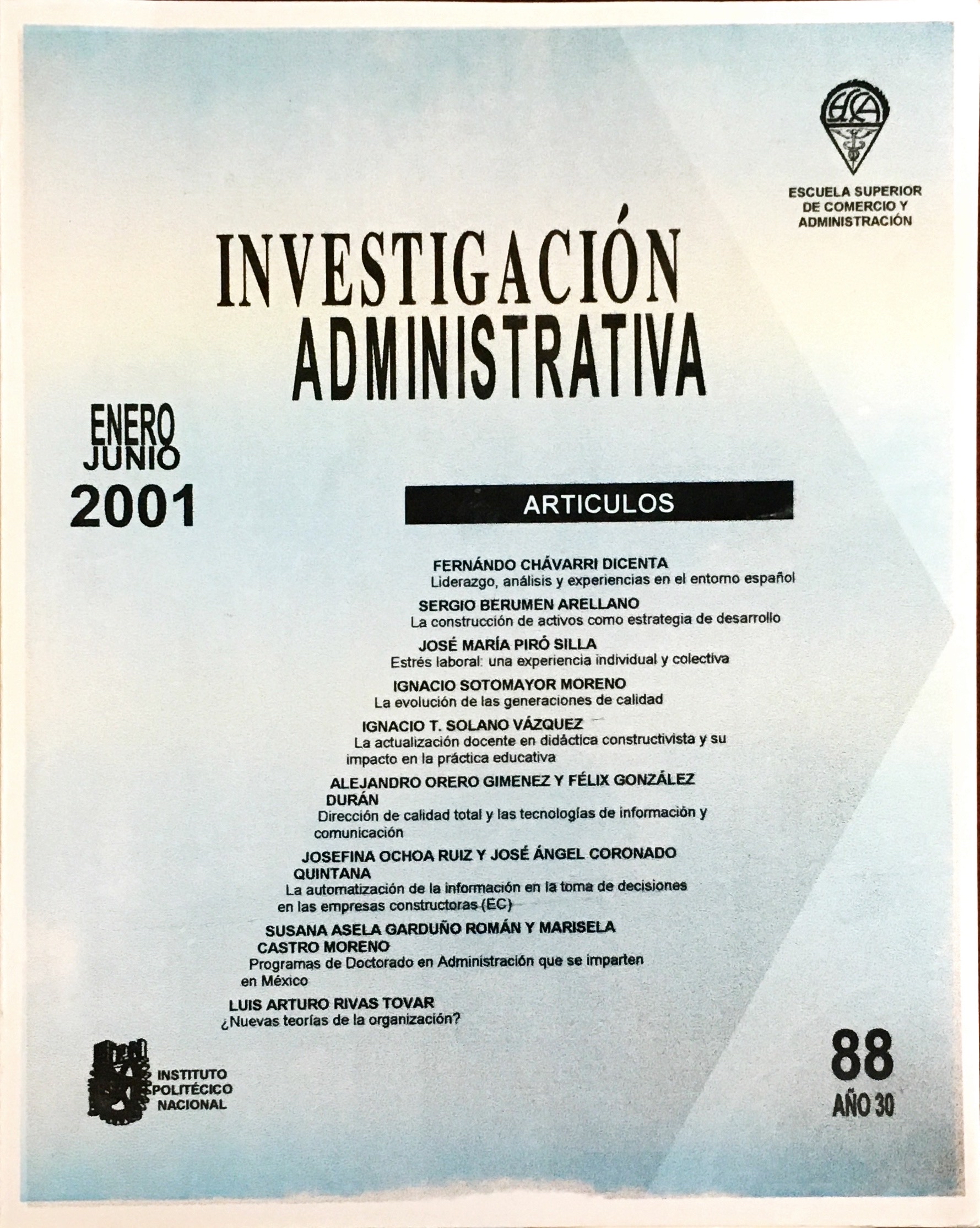LA CONSTRUCCIÓN DE ACTIVOS COMO ESTRATEGIA DE DESARROLLO
Contenido principal del artículo
Resumen
Detalles del artículo

Esta obra está bajo una licencia internacional Creative Commons Atribución-NoComercial 4.0.
Citas
Amsden, Alice (1999). "Three Pronged Investment." Capítulo 5 en The Rise of the Rest. Manuscrito.
Berry, A., et al. (1996) “Globalization, Adjustment, Inequality, and Poverty.” Reporte en UNDP Human Development Report 1997.
Birdsall, N.» Ross, D., and Sabot, R. (1995) “Inequality and Growth Reconsidered: Lessons from East Asia," en World Bank Development Review, Vol. 9, No. 3 (Septiembre)
Centro de Estudios Estratégicos (CEE). (1998) Estrategias de Promoción de Inversión para el Desarrollo Sustentable del Estado de Chiapas. Reporte Fase I. Monterrey, México: ITESM. Reporte Interno.
Centro de Estudios Estratégicos. (1998) La Industria Petroquímica en Veracruz. Reporte elaborado para el Gobierno de Veracruz, México.
Conroy, M. (1998) ‘The Challenges of Economic Geography in Defining, Creating and Defending ‘Sustainable
Duncan, C. (1999) “Equality and Social Capital in Poor Rural Communities” presentado en la conferencia: Social Capital and Poor Communities: Building and Using Social Assets to Combat Poverty.
Gittell, Ross, and Phil Thompson. (1999) “Making Social Capital Work: Blending Social Capital and Other Community Assets in Community Economic Development” presentado en la conferencia: Social Capital and Poor Communities: Building and Using Social Assets to Combat Poverty.
Gotsch, C.H. (1972) "Technical Change and the Distribution of Income in Rural Areas," en American Journal of Agricultural Economics, Vol. 54 (Mayo 2), pp. 326-341.
Gotsch, C.H. (1977) "Agricultural Mechanization in the Punjab: Some Comparative Observations From India and Pakistan." En Land Tenure and Peasants in South Asia, edited by Robert E. Frykenberg. New Delhi: Orient Longman, pp. 182-193.
Harris, J. (1997) "'Missing Link’ or Analytically Missing?: The Concept of Social Capital." En el Journal of International Development, Vol. 9, No. 7, pp. 919-937.
Hart, G. (1997) "Multiple Trajectories of Rural Industrialization: An Agrarian Critique of Industrial Restructuring and the New Institutionalism." En Agrarian Questions: The Cultural and Political Economy of the Agro-Food System in the Late Twentieth Century. New York: Routledge.
Hart, G. (1989) "The Growth Linkage Controversy." Journal of Development Studies, Vol. 25, No. 4, pp. 571-575.
Hazell, P., and Haggblade, S. (1993) "Farm-nonfarm growth linkages and the Welfare of the Poor." Capítulo 8 en Including the Poor, editado por Michael Lipton y Jacques van der Gaag. Presentado en el Simposio organizado por el Banco Mundial y el International Food Policy Research Institute. Washington, D.C.: The World Bank, pp. 190-204.
Humphrey, J., Harris-Pascal, C., and Dolan, C. (1998). "Value Chains and Upgrading: The Impact of UK Retailers on the Fresh Fruit and Vegetables Industry in Africa" Universidad de Sussex, Inglaterra: Institute of Development Studies,.
Meller, P., and Marfan, M. (1981) "Small and Large Industry: Employment Generation, Linkage, and Key Sectors," Economic Development and Cultural Change, Vol. 29 (Enero), pp. 263-274.
Pollak, B., and Williamson, J.G. (1993) "Poverty, Policy, and Industrialization in the Past." Cap. 10 en Including the Poor, editado por Michael Lipton y Jacques van der Gaag. Presentado en el Simposio organizado por el Banco Mundial y el International Food Policy Research Institute. Washington, D.C.: The World Bank, pp. 219-246.
Ranis, G., and Frances Stewart. (1987) "Rural Linkages in the Philippines and Taiwan." In Macro-policies For Appropriate Technology In Developing Countries, editado por Frances Stewart. Boulder. CO: Westview Press, pp. 140-191.
Sen, A. (1995) "The Political Economy of Targeting." Capítulo 2 en Public Spending and the Poor: Theory and Evidence, editado por Dominique van de Walle y Kimberly Nead. Baltimore: The Johns Hopkins University Press, pp. 11-24.
Tendler, J. (1993) "Tales of Dissemination in Small-Farm Agriculture: Lessons for Institution Builders." World Development, Vol. 21, No. 10 (Octubre), pp. 1567-1582.
Tewari, M. (1998) "Intersectoral Linkages and the Role of the State in Shaping the Conditions of Industrial Accumulation: A Study of Ludhiana's Metalworking Industry." World Development, Vol. 26, No. 8, pp. 1387-1411.
Warren, M., Phillip, J. and Saegert, S. (1999) “Social Capital and Poor Communities, ” presentado en la conferencia: "Social Capital and Poor Communities: Building and Using Social Assets to Combat Poverty.”

